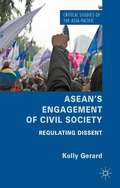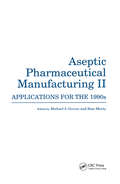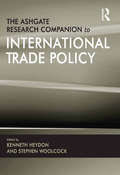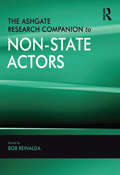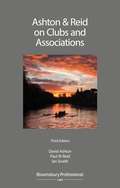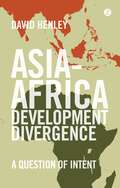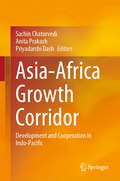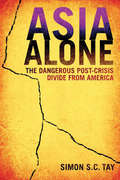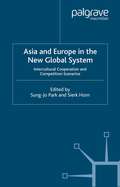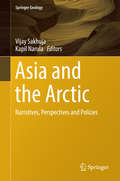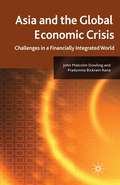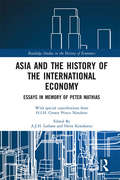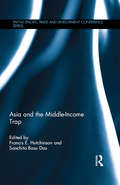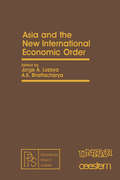- Table View
- List View
ASEAN's Engagement of Civil Society: Regulating Dissent (Critical Studies of the Asia-Pacific)
by Kelly GerardThis book offers an innovative framework for understanding the role of civil society in regional and global policymaking. Using political economy analysis, Gerard demonstrates that ASEAN's people-oriented agenda builds legitimacy, while sidelining its detractors.
Aseptic Pharmaceutical Manufacturing II: Applications for the 1990s
by Michael J. Groves Ram MurtyAsceptic Pharmaceutical Manufacturing II explores the sophisticated technology, developments, and applications that allow aseptic processing to approach the sterility levels achieved with terminal sterilization. Written by experts in sterile manufacturing, this book covers aseptic technology, developments, and applications and makes a valuable contribution to understanding the issues involved in aseptic manufacture. Topics include the processing of biopharmaceuticals, lyophilization, personnel training, radiopharmaceuticals, hydrogen peroxide vapor sterilization, regulatory requirements, validation, and quality systems.
Aseptic Pharmaceutical Manufacturing II: Applications for the 1990s
by Michael J. Groves; Ram MurtyAsceptic Pharmaceutical Manufacturing II explores the sophisticated technology, developments, and applications that allow aseptic processing to approach the sterility levels achieved with terminal sterilization. Written by experts in sterile manufacturing, this book covers aseptic technology, developments, and applications and makes a valuable contribution to understanding the issues involved in aseptic manufacture. Topics include the processing of biopharmaceuticals, lyophilization, personnel training, radiopharmaceuticals, hydrogen peroxide vapor sterilization, regulatory requirements, validation, and quality systems.
The Ashgate Research Companion to International Trade Policy
by Kenneth HeydonThis volume provides a state of the art review of current thinking on the full range of trade policy issues, addressing the economic and political dimensions of international trade policy. The volume contains a systematic examination of: - specific trade policy instruments (such as tariffs, non-tariff barriers and trade rules) - sectoral concerns (in agriculture, manufacturing and services) - trade linkages (to issues such as the environment and labour standards) - systemic considerations (what role for the WTO?) The organising theme of the volume is that open markets for trade and investment yield large potential gains in human welfare as long as trade policy is conducted as an integral part of broader domestic economic management and regulatory reform, and as long as the particular challenges facing developing countries are effectively addressed. This 'case' is presented on the basis of rigorous analysis of first principles and of empirical experience among key trading nations. An integrated set of original and comprehensive perspectives from a diverse group of experts, linked by a common organisational thread. The contributing authors create an ideal mix of internationally recognised experts together with younger specialists making their mark in trade policy analysis; academics as well as trade policy practitioners; and representatives of both developed and developing countries.
The Ashgate Research Companion to International Trade Policy
by Kenneth HeydonThis volume provides a state of the art review of current thinking on the full range of trade policy issues, addressing the economic and political dimensions of international trade policy. The volume contains a systematic examination of: - specific trade policy instruments (such as tariffs, non-tariff barriers and trade rules) - sectoral concerns (in agriculture, manufacturing and services) - trade linkages (to issues such as the environment and labour standards) - systemic considerations (what role for the WTO?) The organising theme of the volume is that open markets for trade and investment yield large potential gains in human welfare as long as trade policy is conducted as an integral part of broader domestic economic management and regulatory reform, and as long as the particular challenges facing developing countries are effectively addressed. This 'case' is presented on the basis of rigorous analysis of first principles and of empirical experience among key trading nations. An integrated set of original and comprehensive perspectives from a diverse group of experts, linked by a common organisational thread. The contributing authors create an ideal mix of internationally recognised experts together with younger specialists making their mark in trade policy analysis; academics as well as trade policy practitioners; and representatives of both developed and developing countries.
The Ashgate Research Companion to Non-State Actors
by Bob ReinaldaHow do non-state actors matter in international relations? This volume recognizes three types of non-state actor: non-governmental organizations (NGOs), intergovernmental organizations (IGOs) and transnational corporations. It illustrates how they play roles alongside nation-states and are interrelated in matters of international regulation and coordination. After an introductory part on current qualitative and quantitative sources, this comprehensive collection of state-of-the-art essays is comprised of four main thematic parts: Part II examines actors other than governments, such as transnational religious actors, business representatives and experts, and also parliamentarians and agencies set up by IGOs. Part III studies the perceptions and understandings in political philosophy, international law and international relations theory. It questions concepts used (civil society, NGO, governance) and covers the limitations to be kept in mind. Part IV analyses the nature and impact of non-state actors. Chapters discuss processes within international bureaucracies (diplomacy, dynamism, bureaucratic power, contribution to democracy) and the quintessence of deliberation and decision making within NGOs and IGOs and of implementation, accountability and dispute settlement. Part V studies specific worlds of non-state actors: humanitarian aid, human rights, security, the North-South divide, health, trade and environment. Accessible and articulately written, The Ashgate Research Companion to Non-State Actors is aimed at a wide readership of scholars and practitioners in international relations.
The Ashgate Research Companion to Non-State Actors
by Bob ReinaldaHow do non-state actors matter in international relations? This volume recognizes three types of non-state actor: non-governmental organizations (NGOs), intergovernmental organizations (IGOs) and transnational corporations. It illustrates how they play roles alongside nation-states and are interrelated in matters of international regulation and coordination. After an introductory part on current qualitative and quantitative sources, this comprehensive collection of state-of-the-art essays is comprised of four main thematic parts: Part II examines actors other than governments, such as transnational religious actors, business representatives and experts, and also parliamentarians and agencies set up by IGOs. Part III studies the perceptions and understandings in political philosophy, international law and international relations theory. It questions concepts used (civil society, NGO, governance) and covers the limitations to be kept in mind. Part IV analyses the nature and impact of non-state actors. Chapters discuss processes within international bureaucracies (diplomacy, dynamism, bureaucratic power, contribution to democracy) and the quintessence of deliberation and decision making within NGOs and IGOs and of implementation, accountability and dispute settlement. Part V studies specific worlds of non-state actors: humanitarian aid, human rights, security, the North-South divide, health, trade and environment. Accessible and articulately written, The Ashgate Research Companion to Non-State Actors is aimed at a wide readership of scholars and practitioners in international relations.
Ashton & Reid on Clubs and Associations
by David Ashton Paul W Reid Ian SnaithThe diversity and complexity of the legal issues that can arise in the course of the activities of a club, society or association present numerous questions for those advising and managing those bodies for which they need guidance. Problems range from the interpretation of rules to anti-discrimination legislation. Legal issues can span alcohol licensing, charities, company law, employment law, expulsion procedures, litigation, meetings, promotion of lotteries, property law and taxation.This is the definitive guide to the legal framework within which clubs, societies and associations operate, bringing together the various strands of law (including new case law and recent legislation) to provide practical legal advice for these bodies, their advisers and officers.The work includes a full set of model rules as well as other useful material in the Appendices.
Asia-Africa Development Divergence: A Question of Intent
by David HenleyWhy have South-East Asian countries like Malaysia, Indonesia and Vietnam been so successful in reducing levels of absolute poverty, while in African countries like Kenya, Nigeria and Tanzania, despite recent economic growth, most people are still almost as poor as they were half a century ago?This book presents a simple, radical explanation for the great divergence in development performance between Asia and Africa: the absence in most parts of Africa, and the presence in Asia, of serious developmental intent on the part of national political leaders.
Asia-Africa Development Divergence: A Question of Intent
by David HenleyWhy have South-East Asian countries like Malaysia, Indonesia and Vietnam been so successful in reducing levels of absolute poverty, while in African countries like Kenya, Nigeria and Tanzania, despite recent economic growth, most people are still almost as poor as they were half a century ago?This book presents a simple, radical explanation for the great divergence in development performance between Asia and Africa: the absence in most parts of Africa, and the presence in Asia, of serious developmental intent on the part of national political leaders.
Asia-Africa Growth Corridor: Development and Cooperation in Indo-Pacific
by Sachin Chaturvedi Anita Prakash Priyadarshi DashThis book is a rich addition to the existing knowledge on models of development partnership among developing countries. Unlike the Belt and Road Initiative (BRI), which exclusively focuses on physical infrastructure development with a strong financing component by China, the Asia–Africa Growth Corridor (AAGC) envisages a holistic approach toward development partnership based on the spirit of triangular cooperation, demystifying the donor-recipient model of development cooperation. By integrating four distinct pillars of cooperation – connectivity and physical infrastructure, capacity building and skill development, development cooperation projects, and people-to-people and business-to-business partnerships – the book provides a succinct account of how a demand-driven people-centric model of engagement among Asian and African countries could help achieve inclusive and sustainable development without creating any fatal dependence on specific countries or institutions for external funding. In sixteen chapters, the book covers various theoretical, analytical, and policy discussions with respect to the concept and modalities of the growth corridor approach under the free, open, and inclusive Indo-Pacific; potential opportunities and challenges in economic sectors and fields like agriculture, manufacturing, trade and investment, urbanization, industrialization, human resource development, and the blue economy; social sector priorities including health, education, skill development, disaster management, and women’s participation; and policy issues relating to trade facilitation, the identification of joint projects, modalities and instruments of project execution, and related aspects. The book offers a valuable resource for students and research scholars working in the fields of development economics, development cooperation, international political economy, and international economic relations. It also serves as a handbook for governments and policymakers on issues concerning the suitability of development projects, sources of and innovations in financing, implementation and execution challenges, private sector involvement, and so on.
Asia Alone: The Dangerous Post-Crisis Divide from America
by Simon S. TayAn insightful examination of the changing relationship between Asia and the United States In this lucidly written and thought-provoking book, author Simon Tay highlights the accelerating trends that point to Asia increasingly forging its own path, independent of the United States. He also describes the fundamental changes and new policy directions needed to maintain and strengthen the bonds between Asia and the United States that have been beneficial to both since the end of the Second World War. On the eve of the global financial crisis of 2008, the economies of the United States and its Asian partners were deeply interdependent. But the different approaches taken to the crisis by Asian and Western leaders point to a new separation that may have negative consequences for the economies and businesses of both regions. To avoid a dangerous divide that may make us all the poorer, Tay reveals what leaders, policy-makers, companies, and citizens can do to find a balance that enriches us all. Written by a leading public intellectual CNN's Fareed Zakaria describes as "one of the most intelligent and reliable guides to the region" Touches on major issues in foreign policy and economics that will impact Asian nations and the United States over the near future Explains the changing nature of economic relations in the global economy For foreign policy followers, politicians, and businesspeople, Asia Alone charts a path forward—together.
Asia Alone: The Dangerous Post-Crisis Divide from America
by Simon S. TayAn insightful examination of the changing relationship between Asia and the United States In this lucidly written and thought-provoking book, author Simon Tay highlights the accelerating trends that point to Asia increasingly forging its own path, independent of the United States. He also describes the fundamental changes and new policy directions needed to maintain and strengthen the bonds between Asia and the United States that have been beneficial to both since the end of the Second World War. On the eve of the global financial crisis of 2008, the economies of the United States and its Asian partners were deeply interdependent. But the different approaches taken to the crisis by Asian and Western leaders point to a new separation that may have negative consequences for the economies and businesses of both regions. To avoid a dangerous divide that may make us all the poorer, Tay reveals what leaders, policy-makers, companies, and citizens can do to find a balance that enriches us all. Written by a leading public intellectual CNN's Fareed Zakaria describes as "one of the most intelligent and reliable guides to the region" Touches on major issues in foreign policy and economics that will impact Asian nations and the United States over the near future Explains the changing nature of economic relations in the global economy For foreign policy followers, politicians, and businesspeople, Asia Alone charts a path forward—together.
Asia and Europe in the New Global System: Intercultural Cooperation and Competition Scenarios
by S. Park S. HornThis book examines the need for co-operation between Europe and Asia, particularly in view of China's accession to the WTO. It looks at the cultural implications for closer cooperation between the two parts of the world, exploring corporate culture and leadership in integration management through mergers and acquisitions. It then goes onto discuss whether the world is big enough for several cultures or whether further integration will result in homogenisation. The authors are leading researchers in the field of economic and cultural co-operation.
Asia and the Arctic: Narratives, Perspectives and Policies (Springer Geology)
by Vijay Sakhuja Kapil NarulaThis book presents narratives, perspectives and policies on the Arctic and brings to fore the strategies of five Asian countries - China, India, Japan, Republic of Korea and Singapore who were granted the status of Permanent Observers in the Arctic Council in 2013. The book also captures Arctic countries’ reactions to Asian approaches, and their expectations from these countries. The melting of the polar sea-ice induced by climate change has placed the Arctic region in the forefront of global scientific, economic, strategic and academic interest. The discourse involves a number of issues such as claims of the littoral countries to the continental shelves of the region, the management and exploitation of its living and non-living resources, the rights and interests of indigenous communities, and the prospects of new ice-free shipping routes. The contemporary discourse also suggests that the Arctic region presents challenges and offers opportunities for the international community. These issues have given rise to new geopolitical, geoeconomic, and geostrategic dynamics amongst the Arctic littorals, and led to the growing interest of non-Arctic states in the affairs of the Arctic. It is evident that the Asian countries have a variety of interests in the Arctic, and the grant of Permanent Observer status to these countries is an acknowledgement of their capabilities. These countries are keen to explore opportunities in the Arctic, and have begun to formulate appropriate long-term national strategies. The preliminary approach of the Asian Observer countries has rightly been to graduate from ‘involvement’ to ‘engagement’ in the Arctic, which seems to have generated significant interest amongst analysts. This book helps to understand the approaches of various Arctic and non-Arctic stakeholders, in light of the evolving dynamics in the region.
Asia and the Global Economic Crisis: Challenges in a Financially Integrated World
by J. Dowling P. RanaThis book provides an analysis of the global economic crisis from an Asian perspective. It examines the impacts of the policy measures adopted, the remaining challenges in rebalancing the global economy, the next steps in regional economic integration in Asia, and issues related to reform of the international financial architecture.
Asia and the History of the International Economy: Essays in Memory of Peter Mathias (Routledge Studies in the History of Economics)
by A. J. H. Latham Heita KawakatsuThis collection of essays sheds new light on many aspects of Asia’s integration with the international economy. H.I.H. Crown Prince Naruhito discusses the problems of controlling water in the interest of urban development. He first examines the problems encountered on the River Thames in relationship to the growth of London in the eighteenth century, and then relates his findings to Japan where similar problems arose with respect to the expansion of Edo (Tokyo). Other chapters looking at the eighteenth century examine the development of plant collecting in Asia and the wider world in the interest of the economy and leisure, Japan’s connections with the outside world by way of the Dutch East India Company (VOC), and the Dutch acquisition of the knowledge of the Japanese language at their base at Dejima Island, Nagasaki. India features next with a chapter showing how India was crucial in initiating the industrial revolution in Britain, by stimulating British manufacturers to copy the fine textiles made by hand loom weavers there. This is followed by a chapter showing how in the late nineteenth century India was the central pivot in the entire international economic system, based on its trading surplus with China. Other discussions trace the role of Scotland as a centre of heavy industry and shipbuilding, with Scottish companies dominating the shipping lanes of Asia. A further chapter shows how British connections with Asia, in this case Shanghai, brought problems of debt and non payment, and outlines the steps taken to try to control the situation. Elsewhere problems arose in Bangkok over the quality of rice being supplied to European merchants in the 1920s, leading to a decline in sales. Finally there is a discussion of Japanese commercial policy towards Africa in the inter-war period. This book will be of interest and use to students, researchers, and general readers interested in Asia’s role in world economic development.
Asia and the History of the International Economy: Essays in Memory of Peter Mathias (Routledge Studies in the History of Economics)
by A. J. H. Latham Heita KawakatsuThis collection of essays sheds new light on many aspects of Asia’s integration with the international economy. H.I.H. Crown Prince Naruhito discusses the problems of controlling water in the interest of urban development. He first examines the problems encountered on the River Thames in relationship to the growth of London in the eighteenth century, and then relates his findings to Japan where similar problems arose with respect to the expansion of Edo (Tokyo). Other chapters looking at the eighteenth century examine the development of plant collecting in Asia and the wider world in the interest of the economy and leisure, Japan’s connections with the outside world by way of the Dutch East India Company (VOC), and the Dutch acquisition of the knowledge of the Japanese language at their base at Dejima Island, Nagasaki. India features next with a chapter showing how India was crucial in initiating the industrial revolution in Britain, by stimulating British manufacturers to copy the fine textiles made by hand loom weavers there. This is followed by a chapter showing how in the late nineteenth century India was the central pivot in the entire international economic system, based on its trading surplus with China. Other discussions trace the role of Scotland as a centre of heavy industry and shipbuilding, with Scottish companies dominating the shipping lanes of Asia. A further chapter shows how British connections with Asia, in this case Shanghai, brought problems of debt and non payment, and outlines the steps taken to try to control the situation. Elsewhere problems arose in Bangkok over the quality of rice being supplied to European merchants in the 1920s, leading to a decline in sales. Finally there is a discussion of Japanese commercial policy towards Africa in the inter-war period. This book will be of interest and use to students, researchers, and general readers interested in Asia’s role in world economic development.
Asia and the Middle-Income Trap (PAFTAD (Pacific Trade and Development Conference Series))
by Francis E. Hutchinson Sanchita Basu DasThe term ‘Middle-Income Trap’ refers to countries which stagnate economically after reaching a certain level of per capita income on the basis of labour- and capital-intensive growth, and are struggling to transition towards more skill-intensive and technology-driven development. It has resonance for the increasing number of countries in Asia who have either languished in middle-income status for extended periods of time, or are worried about growth slow-downs. This book sets outs the conceptual underpinnings of the Middle-Income Trap and explores the various ways it can be defined. It also focuses on the debate surrounding the Middle-Income Trap which questions the appropriate institutional and policy settings for middle-income countries to enable them to continue past the easy phase of economic growth. The book engages with this debate by investigating the role of institutions, human capital, and trade policy in helping countries increase their income levels and by highlighting factors which enable the shift to higher and qualitatively better growth. It questions how the large emerging economies in Asia such as China, Indonesia, and India are currently grappling with the challenges of transitioning from labour-intensive to technology- and knowledge-intensive production, and discusses what can be learnt from the countries that have been able to escape the trap to attain high-income status. Providing a conceptual framework for the Middle-Income Trap, this book will be of interest to students and scholars of Asian Economics, Comparative Economics and Asian Studies.
Asia and the Middle-Income Trap (PAFTAD (Pacific Trade and Development Conference Series))
by Francis E. Hutchinson Sanchita Basu DasThe term ‘Middle-Income Trap’ refers to countries which stagnate economically after reaching a certain level of per capita income on the basis of labour- and capital-intensive growth, and are struggling to transition towards more skill-intensive and technology-driven development. It has resonance for the increasing number of countries in Asia who have either languished in middle-income status for extended periods of time, or are worried about growth slow-downs. This book sets outs the conceptual underpinnings of the Middle-Income Trap and explores the various ways it can be defined. It also focuses on the debate surrounding the Middle-Income Trap which questions the appropriate institutional and policy settings for middle-income countries to enable them to continue past the easy phase of economic growth. The book engages with this debate by investigating the role of institutions, human capital, and trade policy in helping countries increase their income levels and by highlighting factors which enable the shift to higher and qualitatively better growth. It questions how the large emerging economies in Asia such as China, Indonesia, and India are currently grappling with the challenges of transitioning from labour-intensive to technology- and knowledge-intensive production, and discusses what can be learnt from the countries that have been able to escape the trap to attain high-income status. Providing a conceptual framework for the Middle-Income Trap, this book will be of interest to students and scholars of Asian Economics, Comparative Economics and Asian Studies.
Asia and the New International Economic Order: Pergamon Policy Studies on The New International Economic Order
by Jorge A. Lozoya A. K. BhattacharyaAsia and the New International Economic Order discusses issues concerning the establishment of the New International Economic Oder (NIEO) in Asia. The book addresses several themes concerning NIEO in Asia, such as trade, industrialization, food, raw materials, natural resources, regional integration, and socio-cultural issues. The text is comprised of 11 chapters; each tackles a specific region in Asia. The first chapter covers the socio-cultural imperatives. Chapters 2 and 3 discuss Japan’s and South Korea’s relationship with the NIEO, respectively. Chapters 4 and 5 cover China and the NIEO, while Chapters 6 and 7 tackle India and the NIEO. Chapter 8 talks about the natural resources and raw materials in Southeast Asia. Chapter 9 discusses the economic development of the members of the Association of Southeast Asian Nations (ASEAN), while Chapter 10 covers the NIEO-Indonesian relations. The last chapter deals with Australia and the NIEO. This book will be of great use to individuals who are interested in the activities of the NIEO in Asia.
Asia and the Subprime Crisis: Lifting the Veil on the ‘Financial Tsunami’
by C. LoThis is the first book to put together Asia and the developed world in the subprime crisis context and to combine macro and micro analysis to draw lessons from it. The crisis has valuable lessons for the dergulation of China's insurance industry, which is seen as the 'goldmine' in the future of global financial development.
Asia Branding: Connecting Brands, Consumers and Companies
by Bang Nguyen T C Melewar Don SchultzThis is an edited collection examining different elements of branding within the context of Asia. Written by experts, it provides insights into current applied research on the relationship between companies, brands and consumers across key Asian economies.
